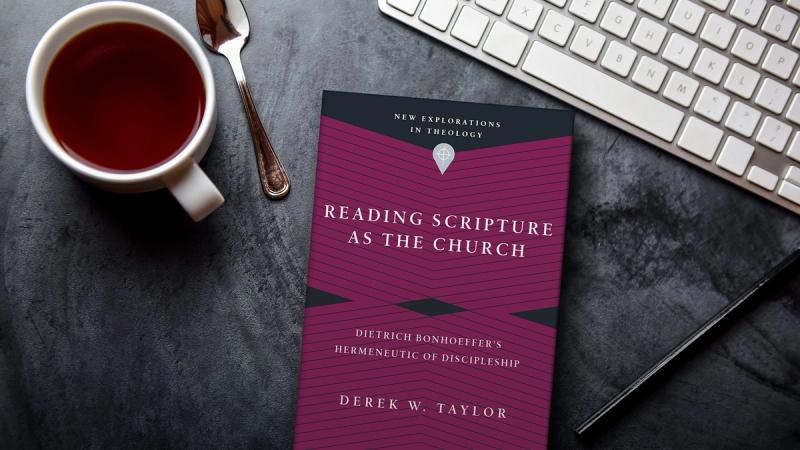Does the church read the Bible differently than others do? If so, how? Derek Taylor’s new book, Reading Scripture as the Church: Dietrich Bonhoeffer’s Hermeneutic of Discipleship, attempts to answer these questions and more, delving into the interplay between hermeneutics and ecclesiology. Taylor charts the way forward to an “ecclesial hermeneutic” that is, “a hermeneutic of discipleship,” where the church reads the Scriptures as disciples, hungry and thirsty, following the Savior.
Taylor, a ThD graduate from Duke, selected a variety of dialogue partners in his examination of the questions related to reading Scripture as the church, showing his appreciation for their insights while also expressing concerns and questions at times. John Webster, Robert Jenson, and Stanley Hauerwas feature heavily, but, as the subtitle suggests, ultimately this book comes back again and again to Dietrich Bonhoeffer. The other dialogue partners only sharpen the questions at hand and provide a context in which Taylor believes Bonhoeffer shines.
While this is an academic book, the issues raised in the book are intensely practical. Do you study the Bible as you would any other book? We have all known people who read the Bible simply to say they have read it, as one might read a school assignment. Much modern biblical criticism can be seen this way: reading the Bible and dissecting it like you would any other book, not receiving it as God speaking to me today.
As a pastor who exegetes and expounds the Word of God regularly, I found Taylor’s book a helpful reminder of the correct posture with which we approach God’s Word. While we use all our exegetical tools to bear on a text, he writes,
The exegete…attend[s] expectantly to the words on the page. Faith…drives the exegetical process, and hope, more than cleverness or technique, characterizes readerly activity. In an almost paradoxical way, confessing inadequacy with regard to the exegetical task actually compels the interpreter to become immersed in the text all the more deeply, with a newfound eagerness that emerges only when the interpreter is released from the pressure to produce (56).
Clearly, the Holy Spirit must illuminate human hearts to grant understanding, and this makes reception of the Word a gift of God. This is one reason why preachers pray for illumination before the proclamation of the Word. We come, in Augustinian and Anselmian fashion, with faith seeking understanding. “When we read Scripture, our ultimate goal is not to know more but to be different. [Bonhoeffer] thus depicts hermeneutics in more holistic terms, in terms of discipleship” (61).
We could even say that Taylor gives a philosophical articulation of the hermeneutic of discipleship outlined in the Westminster Larger Catechism of the 1640s. It asks, “How is the Word of God to be read?” It then answers:
The holy Scriptures are to be read with an high and reverent esteem of them; with a firm persuasion that they are the very Word of God, and that he only can enable us to understand them; with desire to know, believe, and obey the will of God revealed in them; with diligence, and attention to the matter and scope of them; with meditation, application, self-denial, and prayer.
Q&A 157
Readers of the Word must be willing to sit under it, to obey it, and not stand above it in judgment. Taylor suggests that even though the church has traditions as the pillar and buttress of truth, it must be open to the critiques of God’s Word. In this vein, Taylor brings together being a creation of the Word, creatura verbi, with the church being “on the way,” as pilgrims, always reforming according to the Word.
Christ is present in the church, and he enables his sheep to hear his voice (John 10:27), and they follow him. This makes the church a “hermeneutical space.” Rather than being somehow objective, uninterested parties, “Bonhoeffer reminds us that true knowledge requires self-involvement: ‘In order even to see something we need to love it. If we are indifferent toward a person or a thing, we will never understand it’” (80). We lovingly study the Scriptures to know Christ and be conformed into his image.
When situated within the church as the creatura verbi, hermeneutical inquiry terminates with Christ himself. We read so as to have communion with him…The question driving the hermeneutical enterprise is always both ‘What is going on in this text?’ (the penultimate hermeneutical question) and Bonhoeffer’s famous ‘Who is Christ actually for us today?’ (the ultimate hermeneutical question). We ask the first question only because we have already asked the second. In other words, we read the text within the activity of discipleship (81).
Lest we think, however, that we can read as disciples on our own, as a lone wolf apart from others, Taylor reminds us that the Bible “implies…that its reading is a communal and public event. The biblical narrative rarely portrays the act of reading as a solitary affair” (147). Noting communal and public receptions of the Word in 2 Kings 23:1-2, Neh. 8:1-8, Acts 2:42, and Acts 8:26-40, Taylor notes how discipleship and understanding come through the togetherness of God’s people. He highlights Acts 15:28’s Jerusalem council: “It has seemed good to the Holy Spirit and to us…” Taylor explains, “If Hauerwas shows how the church’s historical-institutional dimension requires practices of togetherness, Bonhoeffer does the same with the creatura verbi. If God speaks, the church must be an addressable community equipped to receive and discern the divine address” (151).
Bonhoeffer himself sought this in through his community at Finkenwalde. Taylor summarizes: “The church is a hermeneutical space because it engages in practices of togetherness that sustain a community gathered around the text” (151). Here, Taylor articulates a hermeneutic of bodily presence that is particularly insightful in our days of COVID-19 pandemic lockdowns. “Bodily acts of togetherness are integral to the process of sustaining the church’s narrative embodiment of Christ’s story…Christ’s address does not merely convey data; it creates togetherness. It forges connections that would not exist apart from the miracle of his presence” (172). In other words, disciples of the incarnate Savior live out discipleship bodily: “Bodies moved by grace into community become a source of grace to each other” (173).
We help each other understand how the Word is lived out. Even in our world of commuters where church members live spread apart from each other, pastors know they cannot spend all their time isolated in their study; being with congregants during the week helps a pastor tailor his exposition of the Word to them and helps the congregation to receive it.
Taylor’s book explores far more of these complex issues than any review can adequately relate. Interested readers should take up this work for themselves. Beware, however: this book is not for a popular audience. It is written in an academic style and presupposes a deep familiarity with ecclesiology, hermeneutics, as well as with the figures mentioned in the book. The book moves at a torrential pace—there is certainly little fat and no fluff to trim, and it might have been improved by more explanation of the book’s figures and places, such as the semi-monastic experiment at Finkenwalde.
Likewise, this book stands within the “theological interpretation of Scripture” (TIS) movement, and presumes familiarity with it. Taylor’s account, with Bonhoeffer, emphasizes the outward focus of the church in discipleship—attending to Christ, who is himself engaged on the missio Dei, not to itself and its own existence. He remarks, “Indeed, it is Jesus’ very presence—‘I am with you always’ (Mt 28:20)—that both establishes and sustains the church’s missional existence” (242). This leads him posit an apostolicity of “sentness” (242), a “missional hermeneutic” (247). Taylor’s final section provides some practical “habits” for the church and its “missional hermeneutic,” but one wonders if more of the book should have been spent developing these points.
In sum, this book examines fascinating questions that those who love the Scriptures and the church should joyfully invite. As should be clear above, I think Taylor is on to something. At the same time, while reading I often thought, as D.A. Carson has written about the “theological interpretation of Scripture” movement, “Yes, But…” Finally, while one can only dialogue with so many conversation partners, I wonder if this work would have been enriched by deeper dialogue with other recent works in this field, like Michael Horton’s book People and Place: A Covenant Ecclesiology, Esther Lightcap Meek’s Loving to Know: Covenant Epistemology, and Eric Brian Watkins’s The Drama of Preaching: Participating with God in the History of Redemption.
Andrew J. Miller is the pastor of Bethel Reformed Presbyterian Church (O.P.C.) in Fredericksburg, VA.



